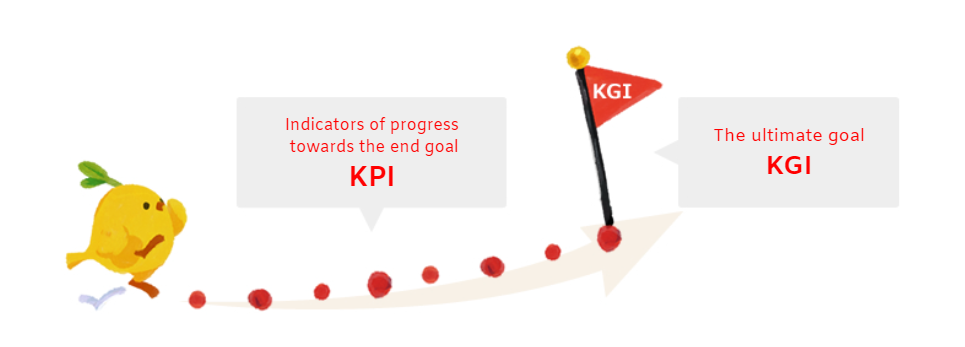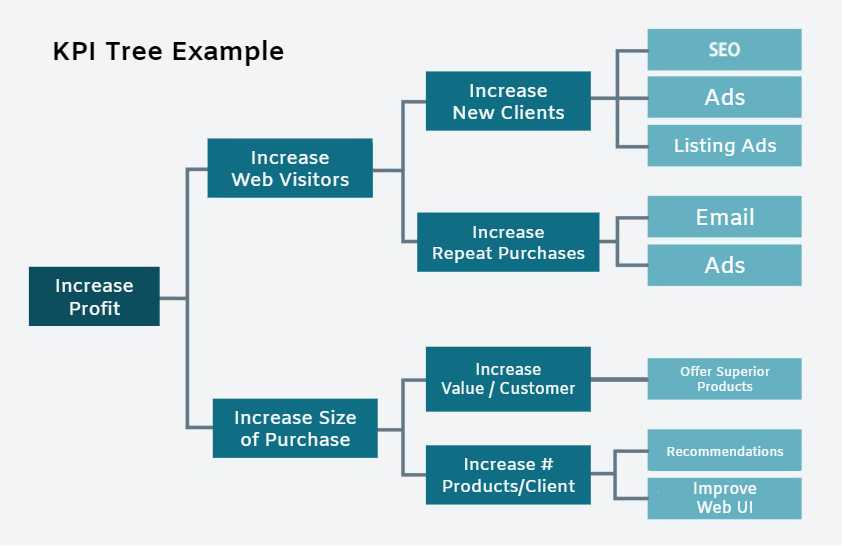The Difference Between KGI, KPI, and OKR: Marketing Metrics

KPIs and KGIs are metrics that are set to be able to evaluate when a company goal has been achieved. For example, you may have an abstract vision or mission for your company, but you also need to set concrete goals that will help you realize the overall mission. KGI stands for “Key Goal Indicator,” and represents the large-scale ultimate goal you want to achieve with your business (e.g. holding the #1 market share for your product). KPI stands for “Key Performance Indicator” and refers to the smaller goals you have to achieve in order to reach the final KGI.
In this article, we’ll go over the basics of KGIs and KPIs, explain how to set them more effectively, and provide some real-life examples as well. Be sure to reference this information to set the right metrics for your business and achieve your ultimate goals.
Want to learn more about the fundamentals of B2B marketing? Join us for our free webinar on B2B marketing and marketing automation, on Friday, November 19, 2021.
Table of Contents
What are KPI and KGI?

KGI (Key Goal Indicator)
A KGI, or “Key Goal Indicator,” is a metric you set to measure whether an important, long-term business goal has been achieved. A KGI is not a vague goal, but a specific numerical value that can be used to objectively judge whether it has been achieved or not.
For example, instead of something like "increase sales," you could set the KGI as "make 100,000 USD sales revenue in 6 months." Then instead of simply trying to "increase customer satisfaction," you could aim to "reach a 85% satisfaction rate based on an email survey of current clients." Clarify your goal with an exact figure of what you want to achieve and give yourself a deadline to achieve it.
KPI (Key Performance Indicator)
Next, a KPI, or “Key Performance Indicator,” points out how effective your current methods are in bringing you closer to your ultimate goal. These are targets for each stage leading up to the KGI. You can figure out what steps you have to take by calculating backward from the final goal, and appropriately set your KPIs. Make sure that your KPIs directly connect to the KGI, and that you will consequently achieve your KGI by succeeding in meeting all your smaller KPIs. In the case that you complete all your KPIs and still haven’t achieved the ultimate goal, it may be necessary to go back and reset your metrics.
The Difference from OKR
OKR stands for "Objective and Key Result," and is a collaborative methodology for setting and tracking goals. OKR was first created by Andy Grove at Intel and has been attracting attention in recent years as major companies such as Google, Facebook, and in Japan, Mercari and CyberAgent have incorporated OKR one after another.
While KPIs allow you to objectively review whether you’re on track to meet your goals, OKR is a model for sharing and visualizing the process to achieve your goals in a team setting. The OKR formula is broken down into a main objective and 3-5 key results, or the actual methods for how you’ll accomplish it.
For instance, if you’re objective is to expand your business abroad, your key results could be (1) to form partnerships with 15 local companies in the first quarter, (2) to have at least 30 subscribers to your service by the end of the quarter, and (3) to hold webinars for local audiences twice a month for lead acquisition.
Note that OKR is often broken down into the different levels of an organization - from the whole company, to departments or teams, to individual employees. Their goals and methods should all connect in this way to the business’s ultimate “Objective.”

The Difference from KSF
Another concept that often gets confused with KPI is KSF, or “Key Success Factor.” KSF refers to the critical factors that determine whether a business is successful in achieving its goals.
To determine your KSFs, you need to research both external factors like market trends and market-entry barriers, as well as internal factors like your company’s strengths and points of differentiation. Note that since KSFs change on a daily basis due to changes in the market or technological advances, it’s necessary to update your business strategies in accordance with the new KSFs to stay successful.
As for the relationship with KPI and KGI, it is best to imagine that by achieving KSF, the KPI can be achieved, and as a result, ultimately the KGI or final goal will be reached.
For example, if your goal is to increase annual sales revenue from your website to $100,000 in three years, picture it like this:
- KGI = Increase sales from website to $100,000 in three years (specific numerical target)
- KPI = Increase the average number of monthly inquiries to 500 within 6 months (specific numerical target)
- KSF = Optimization of site structure, creation of new web pages (actions required to achieve above goals)
How to set KGI and KPI (the process)
KGI is generally set in terms of sales, profit margin, or number of contracts. So first decide with your team what it is you want to achieve, and set specific numerical values to clearly evaluate your success.
Here are some examples:
- Net sales …… "Achieve sales of 500 million USD"
- Number of contracts ...... "Achieve 150% compared to the previous year".
After setting KGI, then you work backwards and set the KPIs, which evaluate the intermediate progress towards the goal.
If your KGI is "Achieve sales of 500 million USD," then your KPIs could include the following:
- Aim for a conversion rate of 8%
- Aim to attract 300,000 visitors to the website
- Aim for 1,000,000 users to visit the site organically
- Aim for 100,000 company name search queries
In this order, to set KPIs, you have to first set the KGI to make sure that the steps to reach the final goal directly connect to it.
KPI Tree
A KPI tree is a way to brainstorm and organize the structure of the KGI and KPIs, and visualize their relationship with branches and leaves in a tree-like diagram. By laying out the whole structure of the KGI and KPIs, you’re able to identify problem areas and address them earlier on, and avoid trying to tackle your mission with non-connecting methods or metrics. Feel free to reference the KPI tree below when working out your own goals.

To provide a couple more examples, here are typical KGIs/KPIs set in HR and in Sales.
HR / Recruitment:
- KGI = Number of job offers accepted
- KPI = Number of job entries, number of applicants for information sessions, number of "excellent candidates" that you especially want to hire, etc.
Sales (in the case of B2B sales)
- KGI = Number of new clients (companies)
- KPI = Number of inquiries, appointments, meetings held, sales pitches, close rate, etc.
Tips for choosing the right KGI and KPI targets
1. Always set something quantifiable.
A common mistake is to set the KGI as something vague like “increase sales.” But you always have to define how much you want to increase your sales so you have a clear goal to aim for. The whole point of KGI and KPI is to have a metric to evaluate your success in relation to your goals, so let’s set them with exact amounts and deadlines to make this possible.
2. Don’t break down your KGI into too many KPIs.
When you set excessive KPIs, the process from the start to end will become too complicated and you won’t be able to properly keep track of each of the metrics. As for the right number of KPIs, set just enough that you can check them on a daily basis without getting overwhelmed.
When drawing out your KPI tree, follow one of the principles of logical thinking, MECE, which stands for “Mutually Exclusive, Collectively Exhaustive.” This means you need to make sure none of your KPI overlap, so you’re not tracking any information twice, but at the same time you can’t omit any important data, so include all of the essential areas that relate to the final KGI.
3. There should be a cause-and-effect relationship between the two.
In the KPI tree, every level of KPIs should connect to the next in a causal relationship. For example, for a smartphone app vendor, if their end goal is to raise the retention rate, then an appropriate KPI would be the login rate or number of shares.
Summary
By setting KGI and KPI properly, you can objectively measure your success in achieving business goals. Large-scale goals like taking the #1 market share in your industry can seem distant and you may be lost as to how to reach them. But by using the KGI/KPI concept or the OKR model, you can break down those huge goals into smaller actionable steps so that you can start getting closer and closer to accomplishing them. As for the next step, try to figure out what ultimate goal you want to achieve in the next couple years and the KPIs that can be used to measure your progress with a KPI tree.
Related articles:
The Top 5 Sales Methodologies to Consider for your Business

.jpg)
.jpg)
.jpg)


